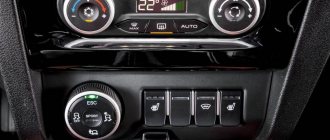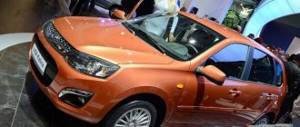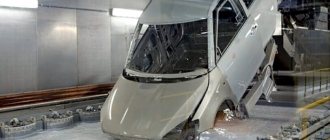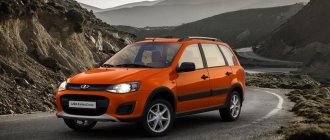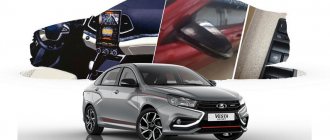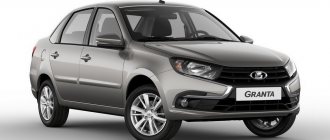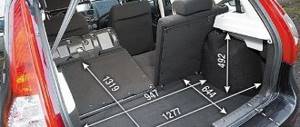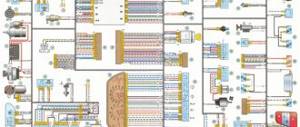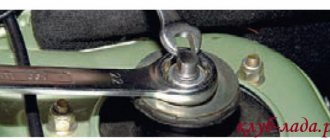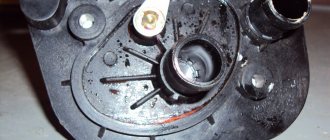How car production began
Development started before the 2000s. So, in 1998, we completed work on the project, which marked the imminent appearance of a new car. AvtoVAZ showed its first concepts in 1999 and 2000, presenting first a hatchback and then a sedan.
The True Kalina was approved only in August 2000, when constructors and designers received technical specifications with an exact indication of what exactly the car should become. The following year, the designers’ project was agreed upon, and already in 2002, the model’s name was registered. Only after this did the preparation of the production field begin.
The first Kalina rolled off the assembly line on February 26, 2004.
The production base included a workshop for welding body parts, painting and a car assembly workshop. Moreover, painting and assembly were carried out in buildings separate from the welding shop, and each of them occupied an area of about 45,000 square meters. The general contractor, which was the Department for Capital Construction of Industrial Buildings and Structures of OJSC AvtoVAZ, took on the bulk of the work to establish the production of a new model of the domestic automobile industry. Another 12 subcontractors were also selected.
Through joint efforts, over the nine months of that very year 2004, the building was landscaped and painting and assembly shops were being prepared. In total, specialists had the opportunity to use more than 60 kilometers of electrical wires, over 5,000 various lamps, more than 400 pieces of technical equipment, and 23 assembly line systems.
Lada Kalina VAZ 2118
LADA Kalina are small class II group cars, which began to be produced in 2004. The first generation of cars in this series rolled off the assembly line until 2013. The development of the project began in 1993, when the concepts of a hatchback, sedan and station wagon were developed. Kalinas were equipped with 1.6 and 1.4-liter engines. The car received ABS, modern air conditioning, heated front seats, electric locks on the remote control, electric power steering. The interior of the car was designed in accordance with global modern standards.
Today it is practically the most comfortable car of domestic production. The high roof makes the interior spacious. The doors received a wide opening angle, and the door openings became larger than those of previous models in the history of VAZ. The door handles have been updated and have become more “tailored” to human anatomy. A lot of plastic and rubber made the doors silent when closed. The hood and trunk lids on the Kalina open almost 90 degrees. It is very comfortable.
The interior of the Lada Kalina car received adjustable seats in several parameters. Now all the tools for adjusting the position of the seats have been moved to their interior. The rear seat in a car can be folded either entirely or in parts. High chairs improve visibility. Everything in the cabin is arranged very thoughtfully; there is plenty of space for both the driver and passengers. Buttons and levers have become more manageable.
Lada Kalina station wagon
The new panel is equipped with advanced stepper motors, all signaling devices have become diode. In addition, the machine is equipped with an on-board sound alarm for malfunctions. The backlight is designed in such a way that no glare falls on the glass. The steering wheel has become optimal in thickness, and the steering column is adjustable. Under the steering wheel there are convenient switches from which you can control the computer.
On the driver's armrest there are control buttons for all power windows and central locking. All this makes driving a complete pleasure. Moreover, the VAZ 2118 inherited the stability of the Samara and the ease of movement of the Ten. All Kalinas take corners quite well at a speed of 77 km/h with a maximum turning radius of 5.2 meters following the outside wheel trail. Lada Kalina received a redesigned gearbox from the “tenth” family. The boxes have become more durable, the lever in the “neutral” position is well fixed.
The lever stroke has become shorter. To avoid accidentally crashing into cars behind you at a traffic light, the car is equipped with an electronic lock for engaging reverse gear. An increased vacuum brake booster has reduced the pedal pressure.
Lada Kalina received modern headlights and interior lighting lamps, which allow you to create both individual narrow light fluxes that do not interfere with traffic at night, and full-fledged interior lighting. A modern heater allows you to warm up the interior up to 30 degrees. All this makes the Kalina family a very modern car, which, in different body configurations, can serve all sorts of human purposes in the progressive world.
The first Lada Kalina cars
Production of the Lada Kalina sedan began on November 18, 2004. On July 21, 2006, the first Kalina hatchback was born. On August 4, 2006, the first new domestic car was sold. In the summer of 2007, production of Kalina began with a new engine, the volume of which was 1.4 liters. In September of the same year, the first Kalina with an ABS system appeared.
Not much time passed, and car enthusiasts were given the opportunity to get acquainted with another new product produced under the name Kalina. This time it was August 2007, and the innovation was a station wagon, which, as it turned out, was liked by many even more than the hatchback and sedan.
Vehicle configuration
Inside the car
The Lada Kalina family was created on the VAZ 2108 platform. The progenitor of the new model received a significantly redesigned chassis, as well as the layout of the power unit and transmission. The angular shapes completely disappeared from the exterior; in general, it could be called modern and inviting. All hard plastic parts have been removed from the interior. The panels became soft and warm, this was especially noticeable in cars produced in 2010-2013. In general, a description of all the changes that the mother platform has undergone can take several pages, so let’s note the main thing: the car has become many times more convenient and safer than the Lada Samara.
From the very beginning of production, the station wagon was offered in 2 trim levels:
- "norm";
- "luxury".
The first configuration had the following set of free options.
- Adjustable steering column.
- Central locking.
- Power windows for front doors.
- On-board computer.
- 14-inch wheels.
- Electric power steering (only in package 11173-140-40).
The luxury version, in addition to everything described above, was additionally equipped with air conditioning and an anti-lock braking system (ABS).
Presentation of the car at the factory
The cost of the top version without ABS in 2013 was 360,000 rubles. For an additional fee, it was possible to install front airbags, foglights and heated front seats. The price of such a package of options was from 25,000 rubles.
Since 2007, the Lada Kalina has been equipped with 2 naturally aspirated gasoline engines:
- VAZ 21114 - 1.6-liter, 8-valve, 81 horsepower;
- VAZ 11194 - 1.4-liter, 16-valve, 89 horsepower.
Depending on the model of the power unit, the station wagon was designated as Kalina 11173 or Kalina 11174. It is important to note that the 8-valve engine was installed only on cars in the “norm” configuration. The 16-valve engine was mainly installed on cars of the “luxury” configuration, but for an additional fee it could also be installed on the Kalina “norm”.
Production problems
Unfortunately, the release of the new Kalina was marred by a couple of unpleasant incidents caused by discovered defects.
So, in 2007, a serious problem was identified in the operation of the steering column, which is why it was necessary to recall over 6,000 cars that were produced between December 2005 and January 2006. The repairs were carried out by the Bryansk-Lada company, an AvtoVAZ dealer.
Over 170 more cars that rolled off the assembly line on May 24 and 25, 2006 were recalled because they were found to have a defect in the steering gear housing.
Kalina’s misadventures did not end there, as about 8.5 thousand cars were recalled back to the manufacturer to fix another problem, which this time lay in the engine mount.
Features of Lada Kalina
Many car enthusiasts were skeptical about the presentation of the Lada Kalina. It was not easy to convince our people that the domestic auto industry is capable of creating a worthy competitor to foreign analogues. According to some, the new model is just a modified body of the “tens”. Is it really?
It is true that the Lada Kalina and the “ten” have a lot in common. But the desire to make a car that would meet the requirements of the West forced manufacturers to use completely new technologies that had not previously been used in the CIS automotive industry. One of the goals of creating Kalina was to adjust it to the state standards of many European countries.
Lada Kalina is perhaps the first Russian car whose safety complies with EuroNCAP (European Committee for the Assessment of Automotive Safety). The most important parts of the machine are made of steel, which has a sufficient reserve of dynamic resistance. This allows the car to withstand impacts without significant damage.
Anti-corrosion protection, which was improved in Togliatti, allows us to guarantee the successful operation of the car for up to 6 years. 49% of the body is made of galvanization and is treated with a special protective paint. This is 20% higher than the VAZ 2110.
The electrical equipment of the Lada Kalina has been improved with a new generator, new wiring harnesses and sealed connectors. The car's battery is protected by a thermal cover. At the same time, there is enough energy to ignite the engine even in 30-degree frost.
The instruments on the panel have high precision characteristics. Lamp signaling devices have been replaced with modern LED ones. The window control unit, created using new mechanisms and technologies and eliminating the possibility of injury when closing the window, is located on the driver's armrest. The on-board computer is superior to the “tens” analogue.
Depending on the body type, the VAZ Kalina has the following approximate characteristics:
- fuel tank volume - 50 l;
- tires - 175/65 R14;
- maximum speed - 185 km/h;
- acceleration to 100 km/h - 11.5 s;
- Gasoline consumption on the highway/in the city - 5.5/10 liters.
The President test drives Kalina
The new car attracted the attention of the country's top leadership in the person of Vladimir Putin, who in May 2007 visited the production of the new product and even organized a kind of test drive.
They put him behind the wheel of a brand new Kalina and asked him to show around the track. According to the president himself, during the tests he managed to accelerate the car to 120 kilometers per hour.
